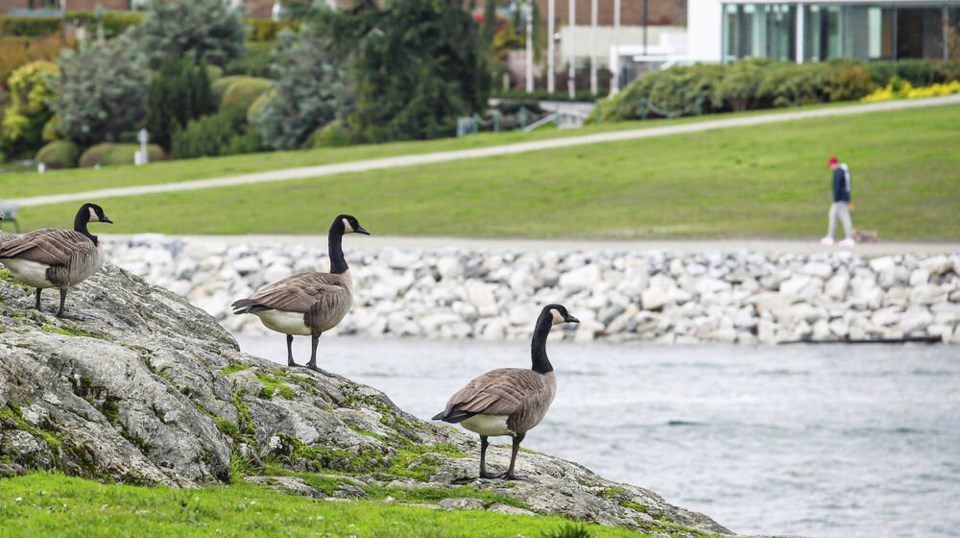News item: A Canada goose from Vancouver Island showed up in Chicago, almost 3,000 kilometres away, much to the surprise of researchers.
I’m lined up at that hot dog cart outside Capital Iron when I hear this voice behind me humming — well, more like honking — an old Robert Johnson tune, Sweet Home Chicago. Except when I glance around, there’s no one there. Strange.
So, I turn back and reach for the condiments, which is when I hear the voice again: “Anybody who puts ketchup on a hot dog is an animal.”
This time, I look down when I turn around, and see him staring up from the sidewalk. “You don’t like animals?” I ask.
“Sure, I do,” he says. “Bears, Bulls, Cubs, Hawks.”
He was peering out from under a Blues Brothers fedora, John Belushi shades balanced on his beak, Patrick Kane jersey hanging to the pavement, webbed feet squeezed into a pair of Air Jordans. That’s when it clicked. “You’re the Chicago goose,” I said.
That’s actually a misnomer. It would be more accurate to call him a Nanaimo goose, since that’s where he was tagged.
Beginning in 2016, Vancouver Island University researchers put individually numbered collars and leg bands on 400 geese as part of a tracking project to help the city get a handle on its goose population — how many there are, where they go, that sort of thing. They set up a website at which people could report seeing the banded birds.
The results showed most stuck around Vancouver Island, though between 10 and 15 per cent ventured as far south as Washington and Oregon. One got plugged by a hunter in Alberta (note to self: retaliation for B.C. blocking their pipeline?), but no others were reported east of the Rockies.
But then, last October, one of the Nanaimo birds was spotted half a continent away by a woman running in Chicago’s Lincoln Park. VIU biology department chair Eric Demers and Stew Pearce, a student when the project began, were flabbergasted. “We have no idea how it got there,” Demers said this week. Maybe it was blown off course by a storm. Maybe its internal compass broke. Dunno.
I posed the question to the goose directly. “Why go to Chicago?”
“I’ve got a cousin there,” he said. “Al Crapone.”
“Tell the truth,” I urged him.
He shrugged. “I wasn’t wanted here.”
Can’t deny that. Even in animal-loving Victoria, where homeless people must dive out of the way of drivers rushing wounded squirrels and raccoons to the veterinary hospital, geese are often regarded with the kind of curled-lip loathing usually reserved for the Boston Bruins or supper-hour phone scammers.
Geese are the bane of farmers, ball players, swimmers, golfers and anyone who simply enjoys the feeling of green grass between bare toes.
Health authorities squirm, too, as do those who worry about damage to ecologically sensitive estuaries. A few years ago it was estimated that Greater Victoria had 6,000 geese that were no longer migratory but a permanent population descended in part from geese imported to the Island for hunting and wildlife-viewing in the 1960s and 1970s. Nanaimo is in the same boat. Saanich Peninsula farmers who rarely saw a goose in the 1990s now lose entire crops in a matter of hours.
Egg-addling efforts did little to change things. Ditto for a 2015 CRD-sponsored goose cull that claimed just 43 of the critters, the cost working out to $725 a bird (your tax dollars at work).
When Prince William and Kate visited Victoria in 2016, a contractor with a specially trained Jack Russell terrier was hired to chase off geese before they could turn the legislature lawn into a royal slip ’n’ slide. The Sooke Soccer Club declared regional director Mike Hicks a “poop hero” for buying a $10,000 machine to scoop goose dung from playing fields in 2020.
That’s the same year the CRD launched a regional goose-management strategy, though it’s not as though this is just a local issue. The grousing about geese has risen with their North American population. (How Geese Became the Assholes of the Sky read the headline in a U.S. publication.)
Even the sports world, littered with names drawn from the Wild Kingdom, shuns them. The four North American major leagues might have 13 teams named for birds — Toronto Blue Jays, Atlanta Falcons, Anaheim Ducks, New Orleans Pelicans and so on — but nobody wants to be called the Canada Geese.
Really, the closest you get are the Beloit Sky Carp, a minor league baseball squad from Wisconsin. Apparently Sky Carp is a derogatory nickname for the Canada goose. We can only assume the more common term — it rhymes with spit hawk — was deemed too coarse.
“You do produce a lot of manure,” I told the Chicago goose.
He lowered his sunglasses. “Have you read your own column?”
“Also,” he said, “geese may be abundant, but North America’s overall bird population has plunged in the past half century. Shouldn’t you be more worked up about that?”



